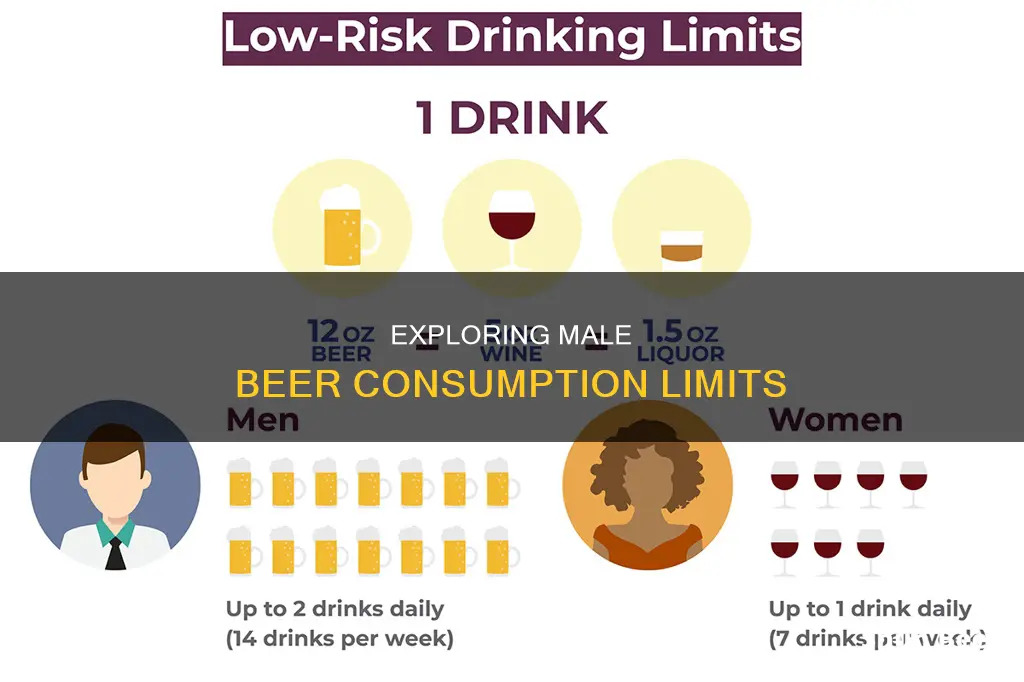
How much beer can men drink? This is a question that many beer-loving males ask themselves, and the answer depends on various factors, including weight, speed of consumption, and health considerations. The legal limit for operating a vehicle in the US is a blood alcohol concentration (BAC) of 0.08, and this can be reached after just a few drinks for smaller men. For example, a 100-pound man will have a BAC of 0.08 after two drinks in two hours, while a 200-pound man will take four drinks in two hours to reach the same level. Men are generally advised to limit their alcohol consumption to two drinks or less per day, which equates to approximately 24 ounces of beer with a 5% alcohol content. However, it's important to note that drinking guidelines are not averages but daily limits, and excessive alcohol consumption can lead to severe health problems, including liver disease, cancer, and heart disease.
| Characteristics | Values |
|---|---|
| Recommended daily limit | 1-2 drinks |
| Recommended weekly limit | 15 drinks |
| Definition of heavy drinking | 5 or more drinks on any day or 15 or more per week |
| Definition of binge drinking | 5 or more drinks within about 2 hours |
| Blood alcohol concentration (BAC) limit for driving | 0.08 |
| Number of drinks to reach BAC limit | 4-5 |
| Number of drinks to reach intoxication | 3 |
| Number of drinks to reach severe intoxication and poisoning | 6 |
What You'll Learn

Men can safely consume two standard drinks per day
In the United States, one "standard" drink contains roughly 14 grams of pure alcohol. This is found in 12 ounces of regular beer, which is usually about 5% alcohol; 5 ounces of wine, which is typically about 12% alcohol; or 1.5 ounces of distilled spirits, which is about 40% alcohol.
The Health Benefits of Alcohol
Drinking alcohol can increase HDL ("good") cholesterol and lower the risk of heart disease. Some research suggests that adults who have one or two alcoholic drinks a day are less likely to die from heart disease than people who don't drink. However, there are healthier ways to get the same benefits, such as exercising.
The Risks of Drinking Too Much Alcohol
Heavy drinking can have very negative effects on the brain, heart, liver, and pancreas. Potential side effects of drinking too much alcohol include mood and behaviour changes, cirrhosis (scarring) of the liver, and cancers of the mouth, oesophagus, throat, liver, and breast.
Binge Drinking
Binge drinking is defined as having five or more drinks for men and four or more drinks for women in about two hours. This typically raises the BAC to 0.08% and meets the definition of binge drinking. Binge drinking causes more than half of the alcohol-related deaths in the US.
Mixing Beer and Adderall: What You Need to Know
You may want to see also

Heavy drinking is defined as more than 14 drinks per week for men
Drinking alcohol can have several health benefits for men, such as improving heart health and increasing HDL (good) cholesterol. However, it is important to practise moderation, as heavy drinking can have detrimental effects on the brain, heart, liver, and pancreas.
Heavy drinking is defined as consuming more than 14 drinks per week for men. Binge drinking, a form of heavy drinking, is characterised by consuming a large quantity of alcohol in a short period, typically resulting in a blood alcohol concentration (BAC) of 0.08% or higher. For men, this usually occurs after having five or more drinks within a two-hour period.
It is important to note that the definition of a "standard" drink varies. In the United States, it refers to 14 grams of pure alcohol, which is equivalent to 12 ounces of beer containing 5% alcohol, 8 ounces of malt liquor containing 7% alcohol, a small 5-ounce glass of wine (12% alcohol), or a 1.5-ounce shot of spirit/liquor (40% alcohol).
Men who choose to consume alcohol should limit themselves to no more than two standard drinks per day and less than 15 drinks per week. It is important to be mindful that certain drinks may count as more than one standard drink, such as craft beer or cocktails.
Additionally, it is worth noting that drinking alcohol is not recommended for everyone. Individuals with certain medical conditions, those taking specific medications, pregnant or planning to become pregnant, and those under the legal drinking age are advised to refrain from consuming alcohol.
HIV and Alcohol: Is Drinking Beer Safe?
You may want to see also

A standard drink is 14 grams of alcohol
The amount of beer a male can drink depends on various factors, including his weight, height, metabolism, and whether they have consumed any food. Generally, drinking in moderation is considered two "standard" drinks or less per day for men.
In the United States, a standard drink or alcoholic drink equivalent contains roughly 14 grams of pure alcohol. This is found in 12 ounces of regular beer, which is usually about 5% alcohol. The amount of alcohol in a drink is determined by the volume of the beverage and the percentage of alcohol present.
For example, a 12-ounce can of regular beer, which is typically 5% alcohol, is considered one standard drink. This is because it contains approximately 14 grams of alcohol.
Other examples of one standard drink include:
- 5 ounces of wine, which is typically about 12% alcohol
- 1.5 ounces of distilled spirits, which is about 40% alcohol
- 8 ounces of malt liquor, which is typically 7% alcohol
It's important to note that the standard drink is a guideline and may not reflect customary serving sizes. Additionally, the definition of a standard drink varies from country to country, with values ranging from 8 to 20 grams of alcohol.
Beer and Jock Itch: A Recipe for Disaster?
You may want to see also

Men metabolise alcohol faster than women
When it comes to alcohol consumption, guidelines recommend drinking in moderation. For men, this means consuming two "standard" drinks or less per day. A standard drink contains 14 grams of pure alcohol and is equivalent to a 12-ounce beer with 5% alcohol. While drinking in moderation may offer some health benefits, such as improved heart health, excessive alcohol consumption can lead to negative health effects.
Additionally, women have lower levels of alcohol dehydrogenase, an enzyme responsible for breaking down alcohol before it reaches the bloodstream. This results in higher blood alcohol levels in women compared to men, even when consuming the same dose. Furthermore, studies suggest that women may be more susceptible to alcohol-related cognitive impairments, such as delayed memory and divided attention functions, than men. However, psychomotor performance impairments, such as eye-hand coordination and body sway, do not appear to be influenced by gender.
It is important to note that the rate of alcohol metabolism is relatively constant for an individual, regardless of the amount consumed or attempts to sober up. The body begins to metabolise alcohol within seconds of ingestion, primarily through the enzyme alcohol dehydrogenase (ADH) in the liver. While men may metabolise alcohol faster, it is crucial to drink responsibly and within recommended limits to avoid negative health consequences.
Beer and Meloxicam: Safe or Not?
You may want to see also

Drinking alcohol can increase the risk of certain cancers
According to the US Dietary Guidelines for Americans, men should limit their alcohol consumption to two drinks or less per day. However, drinking alcohol, even in moderate amounts, can increase the risk of certain cancers.
Alcohol is a known human carcinogen, and there is a strong scientific consensus that alcohol consumption can cause several types of cancer. The evidence indicates that the cancer risk increases with the amount of alcohol consumed, especially over time. Even those who have no more than one drink per day or engage in binge drinking have a slightly higher risk of developing certain cancers.
Drinking alcohol is associated with a higher risk of the following types of cancer:
- Head and neck cancer: Moderate to heavy alcohol consumption is linked to a higher risk of oral cavity, pharynx (throat), and larynx (voice box) cancers. The combination of alcohol and tobacco use significantly increases the risk of these cancers.
- Esophageal cancer: Any level of alcohol consumption is associated with an increased risk of esophageal squamous cell carcinoma. The risk is substantially higher for heavy drinkers.
- Liver cancer: Heavy alcohol consumption is linked to approximately twice the risk of developing hepatocellular carcinoma and intrahepatic cholangiocarcinoma.
- Breast cancer: Epidemiological studies have found a positive relationship between alcohol intake and breast cancer risk. The risk increases with each additional drink.
- Colorectal cancer: Moderate to heavy alcohol consumption is associated with a higher risk of cancers of the colon and rectum.
In addition to the above, there is growing evidence that alcohol consumption is linked to increased risks of melanoma, prostate cancer, and pancreatic cancer. While some studies suggest that moderate drinking may have potential health benefits, such as improved heart health, the risks of alcohol consumption, particularly the increased risk of cancer, outweigh any potential benefits.
Therefore, it is important for men to follow the recommended guidelines and limit their alcohol consumption to reduce the risk of alcohol-related cancers and other adverse health effects.
Root Beer and Teens: Is It Safe to Drink?
You may want to see also
Frequently asked questions
Moderate drinking is considered two "standard" drinks or less per day for men. A standard drink is 14 grams of pure alcohol, which is the same as 12 ounces of beer containing 5% alcohol.
This depends on various factors, such as weight, metabolism, and drinking speed. As a general rule, the average-sized American man may not feel intoxicated after drinking four beers in two hours, but five beers are likely to lead to a blood alcohol concentration (BAC) of 0.08% or higher, which is above the legal limit for driving.
Heavy drinking for men is defined as consuming more than 14 drinks per week. Binge drinking, which is a type of heavy drinking, occurs when men consume five or more drinks within about two hours, leading to a BAC of 0.08% or higher.
Authorities in the US recommend a target of no more than 196 grams of alcohol per week for optimal health and longevity. This is equivalent to about 14 standard drinks or roughly 14 bottles of 5% beer.







